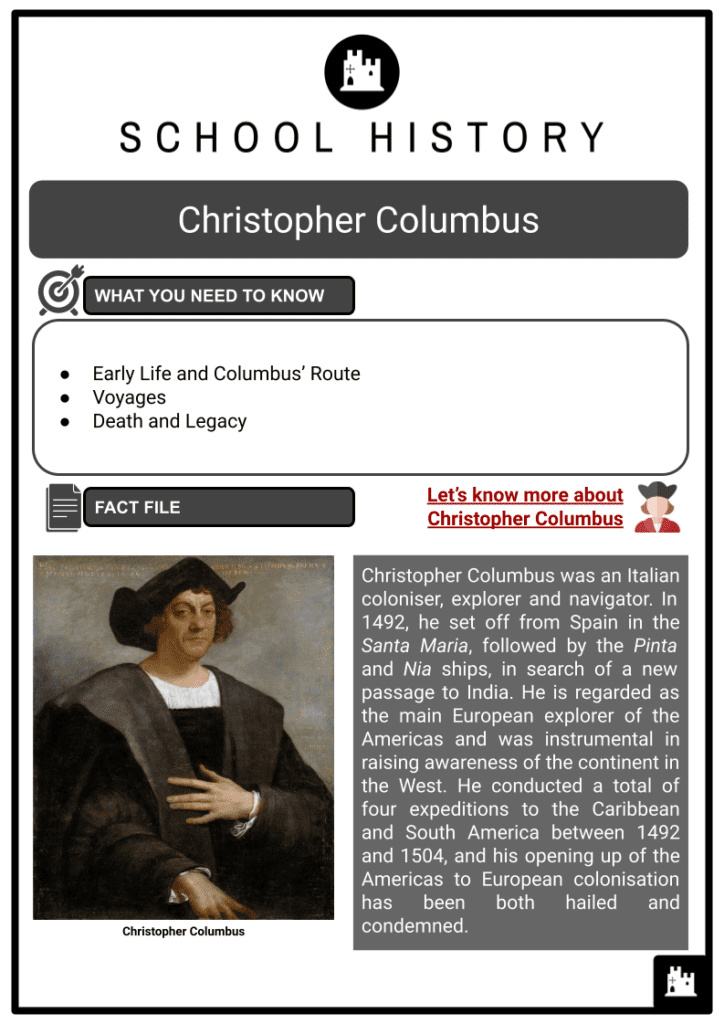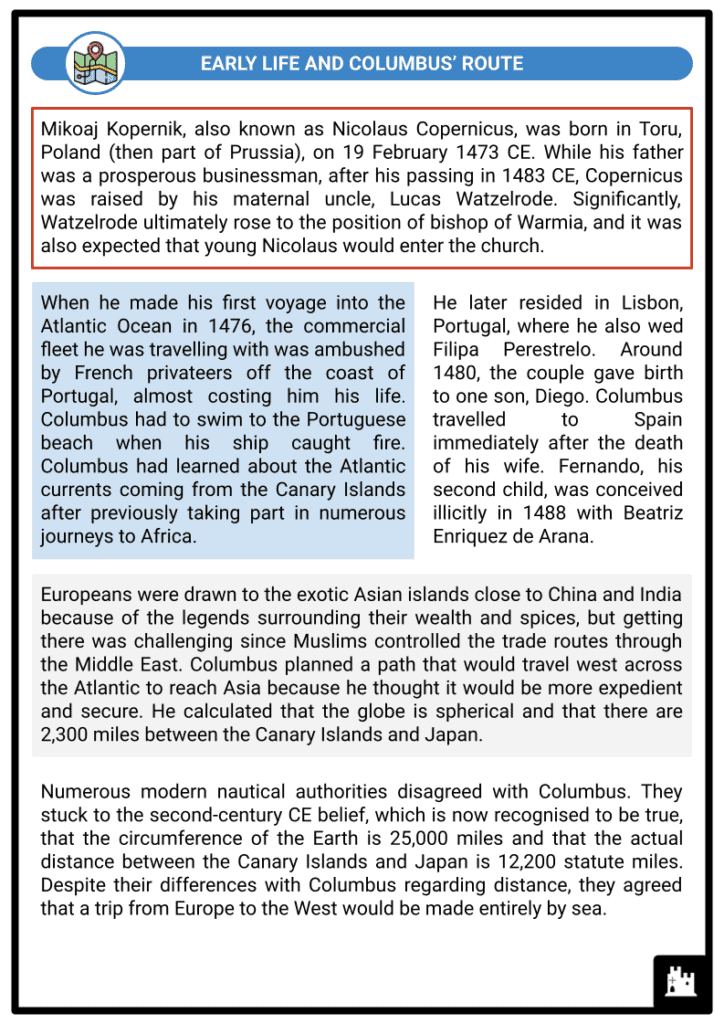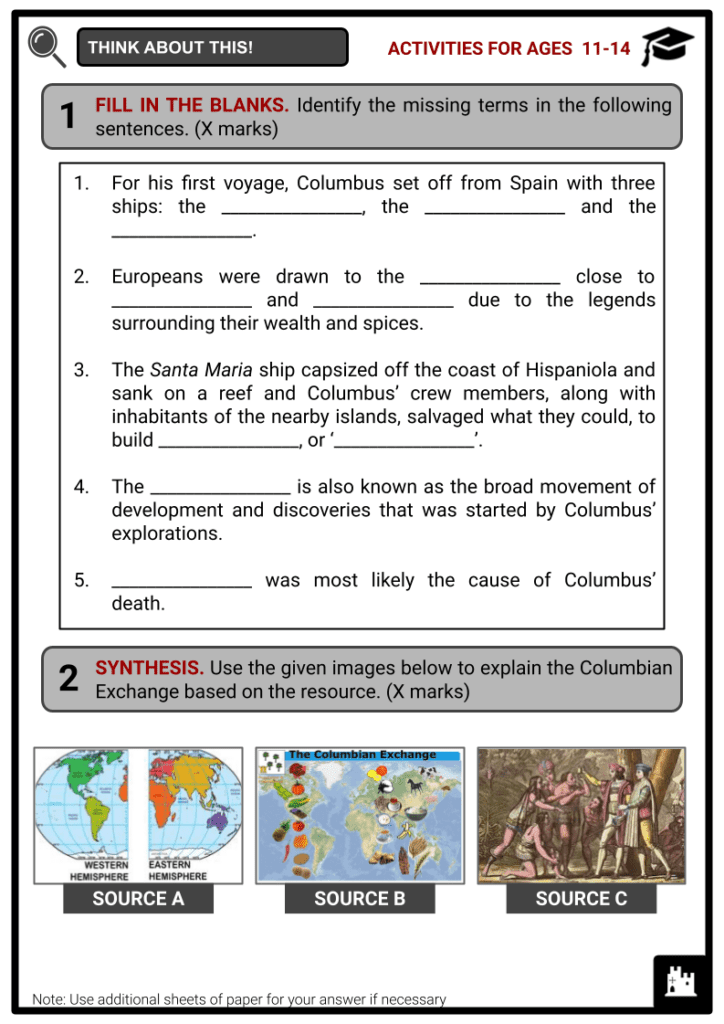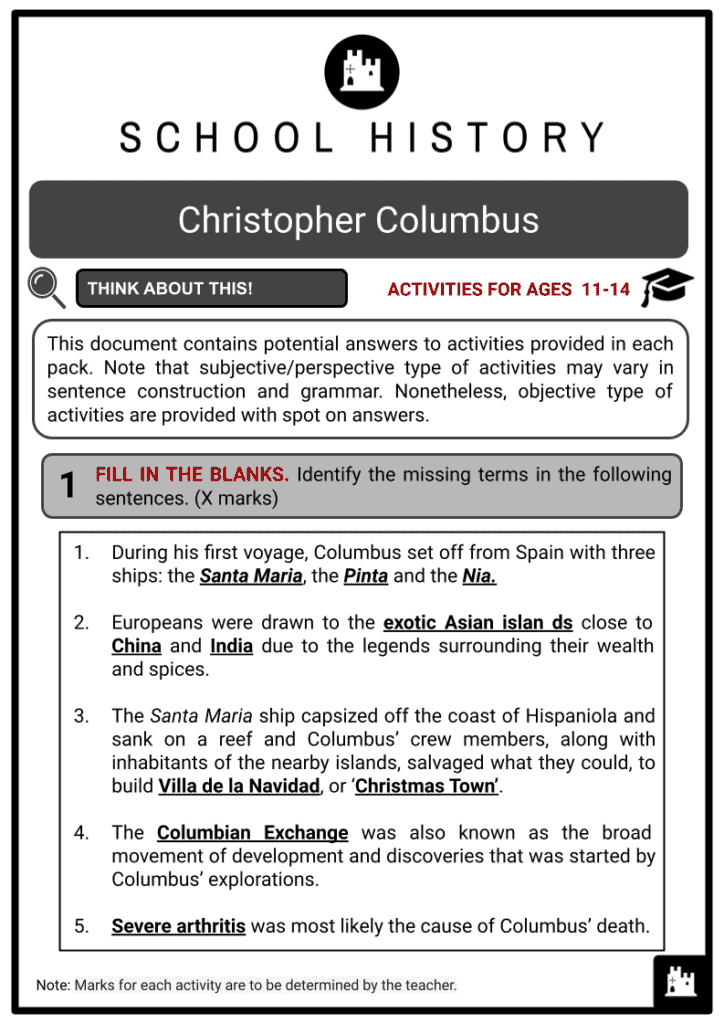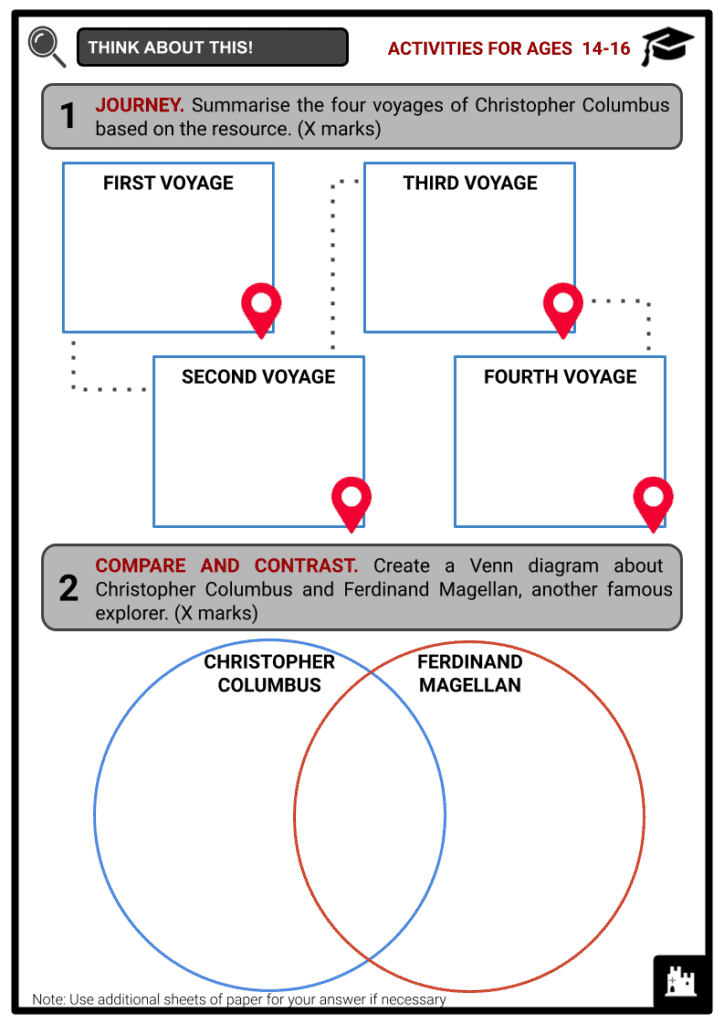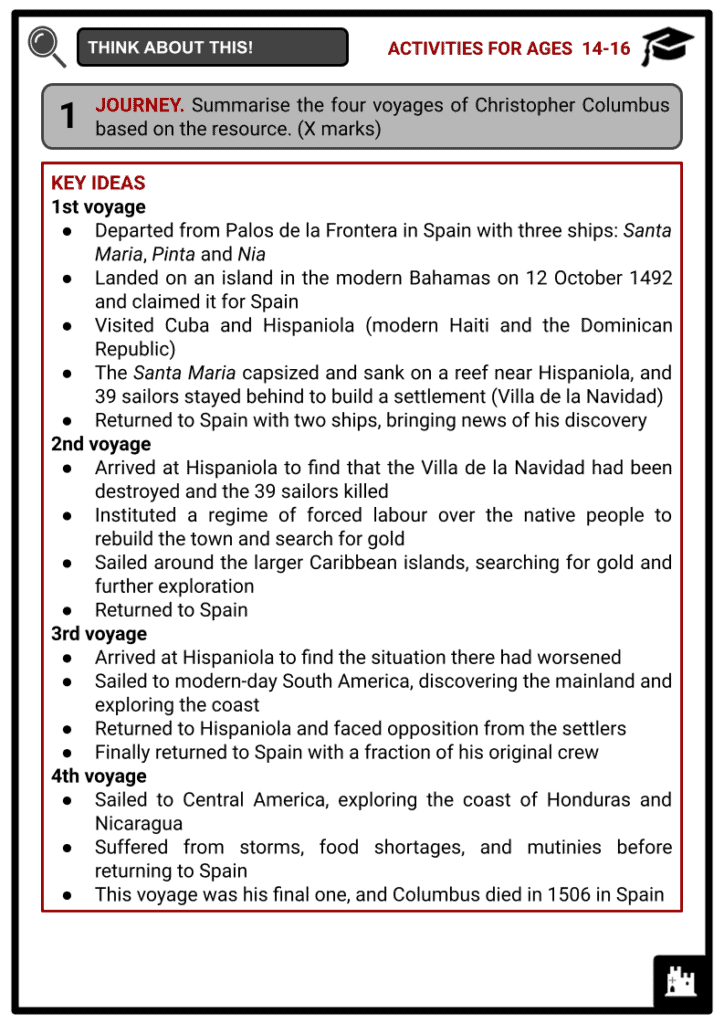Christopher Columbus Worksheets
Do you want to save dozens of hours in time? Get your evenings and weekends back? Be able to teach about Christopher Columbus to your students?
Our worksheet bundle includes a fact file and printable worksheets and student activities. Perfect for both the classroom and homeschooling!
Summary
- Early Life and Columbus’ Route
- Voyages
- Death and Legacy
Key Facts And Information
Let’s know more about Christopher Columbus!
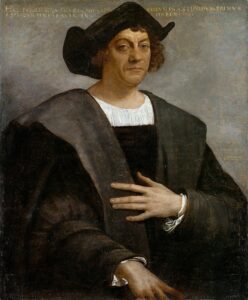
Christopher Columbus was an Italian coloniser, explorer and navigator. In 1492, he set off from Spain in the Santa Maria, followed by the Pinta and Nia ships, in search of a new passage to India. He is regarded as the main European explorer of the Americas and was instrumental in raising awareness of the continent in the West. He conducted a total of four expeditions to the Caribbean and South America between 1492 and 1504, and his opening up of the Americas to European colonisation has been both hailed and condemned.
EARLY LIFE AND COLUMBUS’ ROUTE
- Mikoaj Kopernik, also known as Nicolaus Copernicus, was born in Toru, Poland (then part of Prussia), on 19 February 1473 CE. While his father was a prosperous businessman, after his passing in 1483 CE, Copernicus was raised by his maternal uncle, Lucas Watzelrode. Significantly, Watzelrode ultimately rose to the position of bishop of Warmia, and it was also expected that young Nicolaus would enter the church.
- When he made his first voyage into the Atlantic Ocean in 1476, the commercial fleet he was travelling with was ambushed by French privateers off the coast of Portugal, almost costing him his life. Columbus had to swim to the Portuguese beach when his ship caught fire. Columbus had learned about the Atlantic currents coming from the Canary Islands after previously taking part in numerous journeys to Africa.
- He later resided in Lisbon, Portugal, where he also wed Filipa Perestrelo. Around 1480, the couple gave birth to one son, Diego. Columbus travelled to Spain immediately after the death of his wife. Fernando, his second child, was conceived illicitly in 1488 with Beatriz Enriquez de Arana.
- Europeans were drawn to the exotic Asian islands close to China and India because of the legends surrounding their wealth and spices, but getting there was challenging since Muslims controlled the trade routes through the Middle East. Columbus planned a path that would travel west across the Atlantic to reach Asia because he thought it would be more expedient and secure. He calculated that the globe is spherical and that there are 2,300 miles between the Canary Islands and Japan.
- Numerous modern nautical authorities disagreed with Columbus. They stuck to the second-century CE belief, which is now recognised to be true, that the circumference of the Earth is 25,000 miles and that the actual distance between the Canary Islands and Japan is 12,200 statute miles. Despite their differences with Columbus regarding distance, they agreed that a trip from Europe to the West would be made entirely by sea.
- Columbus originally suggested a three-ship transatlantic expedition to the Portuguese monarch, then to Genoa, and ultimately to Venice. He was turned down every time.
- He visited the Spanish monarchies of Ferdinand II of Aragon and Queen Isabella of Castile in 1486. They originally rejected Columbus because they were focused on a battle with the Muslims and because their nautical experts were dubious.
- However, the monarchs must have been attracted by the concept since Columbus was kept on retainer. The final Muslim bastion was shortly taken by the Spanish army at Granada in January 1492 as a result of Columbus’ persistent lobbying of the royal court. The monarchs quickly consented to fund his mission after that.
- Columbus departed from the port of Palos de la Frontera in late August 1492.
- Columbus was travelling on three different ships: the Pinta and the Nia, two caravels in the Portuguese style, and the larger Santa Maria, a carrack.
VOYAGES
- After 36 days of sailing westwards over the Atlantic, Columbus and a few members of his crew landed on an island in the modern Bahamas on 12 October 1492, and claimed it for Spain. His crew came across a frightened but amiable tribe of locals who were willing to deal with the sailors for parrots, spears, glass beads and cotton balls. The indigenous’ jewellery was made of gold, which the Europeans also saw.
- Columbus and his crew resumed their voyage, stopping at the islands of Cuba (which he mistakenly believed to be mainland China) and Hispaniola, which are now Haiti and the Dominican Republic, and meeting with the local chiefs.
- Off the coast of Hispaniola, the Santa Maria capsized during this period and sank on a reef.
- Columbus’ sailors rescued what they could with the assistance of local islanders, using the ship’s timber to construct Villa de la Navidad, or ‘Christmas Town’.
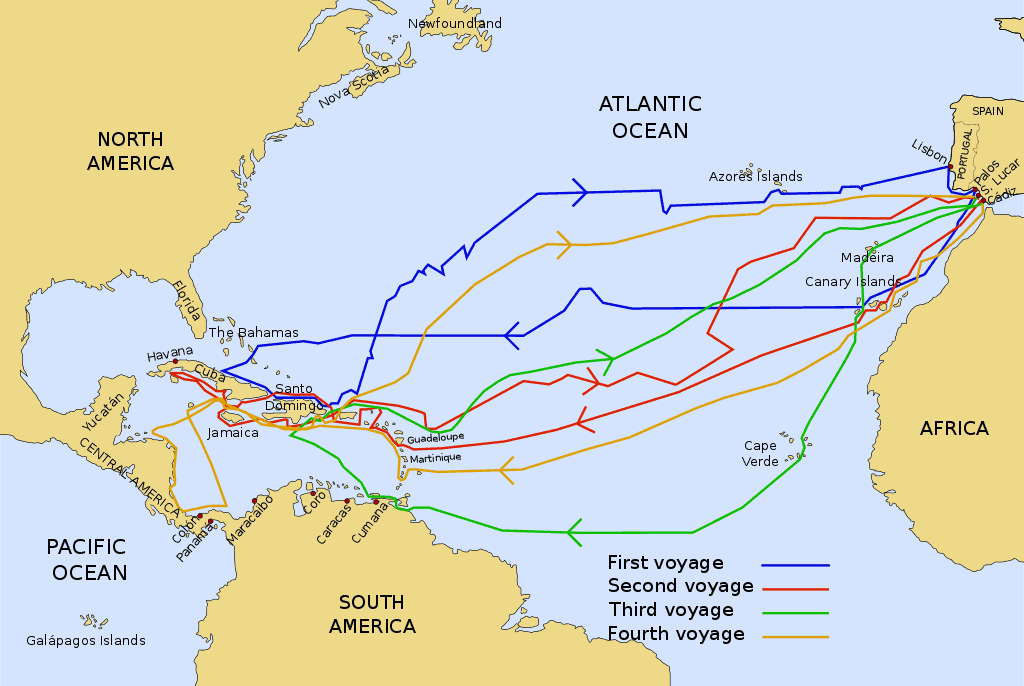
Map showing the four voyages of Columbus - To maintain the town, 39 men remained behind. After concluding that his exploration had reached Asia, Columbus decided to leave with the two remaining ships and head back home.
- Columbus provided a laudatory, if slightly overstated, account upon his return to Spain in 1493, and the royal court welcomed him with open arms.
- Columbus embarked on his second maritime voyage in 1493 and discovered further Caribbean islands. When Columbus and his crew arrived on Hispaniola, they found that the Navidad town had been demolished and that all of the sailors had been killed.
- Columbus instituted a regime of forced labour over the native people to rebuild the town and search for gold, believing it would be profitable, disregarding the views of the local queen who found slavery distasteful. Little gold was produced as a result of his efforts, but the native populace was extremely hostile.
- Columbus quickly cruised around the bigger Caribbean islands to further persuade himself he had discovered the outlying islands of China before sailing back to Spain, leaving his brothers Bartholomew and Diego in charge of overseeing the settlement on Hispaniola.
- Columbus didn’t get on the continent until his third expedition, when he went to present-day Venezuela to explore the Orinoco River. Unfortunately, the situation in the Hispaniola settlement had gotten so bad that there was almost a rebellion, with the settlers claiming they had been duped by Columbus’ promises of riches and the inept leadership of his brothers.
- A royal representative from the Spanish Crown deposed Columbus and had him jailed. He travelled back to Spain in shackles so that he could confront the king. Although the accusations were subsequently dismissed, Columbus lost his position as governor of the Indies and, for a while, a significant portion of the wealth he had amassed throughout his explorations.
- Columbus embarked on his last voyage in 1502 after persuading King Ferdinand that one more trip would deliver the copious riches promised.
- He travelled down the eastern coast of Central America in a fruitless attempt to find a passage to the Indian Ocean.
- The captain and his crew were left stranded on the island of Cuba when one of his ships was destroyed by a hurricane.
- Local islanders during this period turned down meals from the Spaniards because they were fed up with their mistreatment and obsession with gold.
- In a moment of inspiration, Columbus looked up the moon’s position in an almanac and came up with a scheme to ‘punish’ the islands.
- A lunar eclipse on 29 February 1504 scared the locals sufficiently to restart commerce with the Spaniards.
- Columbus and his men were ultimately rescued in November of 1504 after being dispatched by the royal ruler of Hispaniola in July.
- After his final trip to the Americas, Columbus tried to regain his lost titles during the final two years of his life.
- He did get part of his money back in May 1505, but his titles were never given back.
DEATH AND LEGACY
- Columbus, who was 41 at the time, had experienced a gout attack on his first return journey during a severe storm. In the years that followed, he was troubled by what was supposed to be influenza, various fevers, eye haemorrhage, temporary blindness, and protracted gout episodes. The assaults got worse and more frequent, often forcing Columbus to stay in bed for months on end, and resulted in his passing 14 years later. On 20 May 1506, after contracting an illness, Columbus most likely passed away from severe arthritis.
- Columbus has been held responsible for both the annihilation of the indigenous populations of the islands he discovered and the opening of the Americas to European colonisation. In the end, he was unable to locate the riches and fresh path to Asia that he had been searching for.
- Columbus’ travels initiated the broad movement of people, plants, animals, illnesses and civilisations that had a significant impact on almost every civilisation on Earth, known as the Columbian Exchange.
- Native American tribes in North America’s Great Plains were able to transition from a nomadic to a hunting lifestyle thanks to the European horse. Old World wheat quickly replaced native crops as the primary food source for humans in the Americas. Major revenue crops for Latin American nations include coffee from Africa and sugar cane from Asia. Additionally, American goods like potatoes, tomatoes and corn became mainstays for Europeans and contributed to the expansion of their populations.
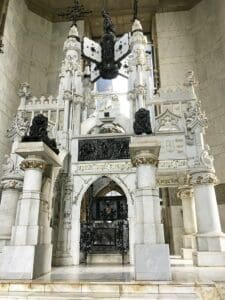
Columbus Lighthouse - Both hemispheres were affected by new illnesses introduced by the Columbian Exchange, although the impacts were more severe in the Americas. Millions of Native Americans were reduced to tiny fractions of their former population by the Old World smallpox epidemic. This, more than any other element, made it possible for Europe to rule the Americas.
- It is estimated that the Native American population in the Americas was approximately 50 million before Christopher Columbus arrived. However, after his arrival, the population started to decline rapidly due to a combination of factors such as disease, warfare and enslavement. According to the American Philosophical Society, the population of the Americas was reduced to around 6 million by the 17th century.
- The introduction of new diseases by European explorers was a significant factor in the decline of the Native American population. The Native Americans had no immunity to diseases such as smallpox, measles and influenza, which resulted in a rapid spread of the diseases, causing up to 90% of the Native American population to die from them.
- European colonisation also led to the decline of the Native American population through violence and enslavement. Columbus and other explorers forced Native Americans to work in gold mines and plantations, subjected them to brutal conditions, and waged war against them as Europeans sought to expand their territories.
- Christopher Columbus’ legacy is a complex and controversial issue, as his voyages had a profound impact on the Native American population. Although Columbus’ explorations opened the New World to European colonisation, they also resulted in the decline and devastation of Native American communities. To fully comprehend Columbus’ legacy, a detailed examination of historical records and statistics is necessary.
Image Sources
- https://en.wikipedia.org/wiki/Christopher_Columbus#/media/File:Portrait_of_a_Man,_Said_to_be_Christopher_Columbus.jpg
- https://en.wikipedia.org/wiki/Christopher_Columbus#/media/File:Viajes_de_colon_en.svg
- https://en.wikipedia.org/wiki/Christopher_Columbus#/media/File:Columbus_Tomb_Dominican_Republic_01_2018_6805.jpg

